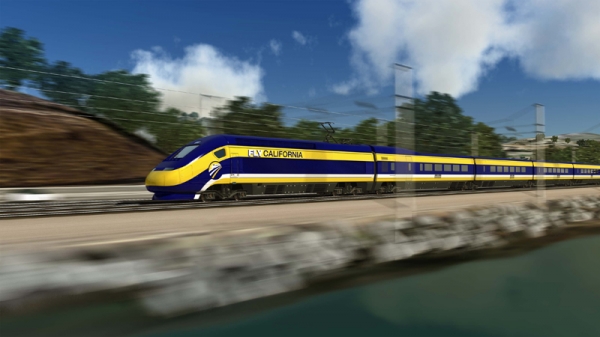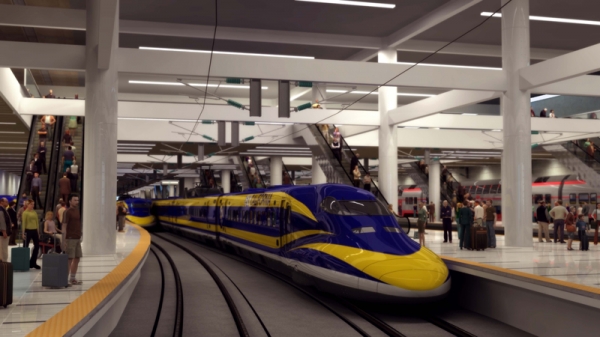The state agency charged with building California's high-speed rail system approved on Thursday a long-debated environmental analysis for the San Francisco-to-Los Angeles line -- a voluminous document that the project's opponents immediately characterized as an invitation to more lawsuits.
The California High-Speed Rail Authority voted to "recertify" the final Program Environmental Impact Report (EIR), a high-level document that describes the voter-approved project and that designates the Pacheco Pass as the rail authority's preferred route to the Peninsula. The authority had previously approved the document on two occasions, but it was forced both times to revise the document after legal challenges from Peninsula cities and nonprofit groups.
Now, Palo Alto, Atherton and Menlo Park are preparing for round three. Stuart Flashman, the attorney representing the Peninsula cities in two lawsuits against the rail authority, submitted on April 13 a notice that the cities will appeal the November 2011 ruling, which required the rail authority to make several technical revisions in the program analysis but which did not force the agency to re-examine Pacheco or ridership numbers. The basic argument from the cities is that the newly revised EIR still fails to comply with state law because of questionable ridership data and a failure to examine a two-track design on the Peninsula.
Much of the legal dispute centered on the rail authority's choice of the Pacheco Pass over the Altamont Pass. Board members acknowledged Thursday that both routes have merit, but they declined to reconsider the preferred alternative for the $68 billion line.
Board Chair Dan Richard called the dispute over routes the "biggest struggle" for him. His board colleague, Jim Hartnett, agreed.
"Frankly, with a lot to commend each, in my heart of hearts I still think the Pacheco is the preferable alternative," Hartnett said.
Several speakers vehemently disagreed. David Schonbrunn, president of the Transportation Solutions Defense and Education Fund (TRANSDEF) and Richard Tolmach, president of California Rail Foundation, both urged the rail authority to reconsider the route. Both groups took part in the litigation against the rail authority.
"If you insist on certifying this document, you will be back in court and lose," Schonbrunn said.
"Have you learned anything from this organization's two previous expensive and time-consuming losses?" he later added.
Tolmach raised questions about the new document's ridership numbers, which have been contested by the Palo Alto-based watchdog group Californians Advocating Responsible Rail Design (CARRD) and by the independent experts from UC Berkeley's Institute for Transportation Studies.
"What you're basing this bad EIR on is a set of already discredited ridership figures," Tolmach said. "You need to get a fresh look."
City leaders in Palo Alto and Menlo Park have also insisted that the rail authority evaluate the "blended" alternative for high-speed rail -- a design under which the rail system would share two tracks with Caltrain on the Peninsula. Though the rail authority had agreed to pursue the blended option, the program EIR devotes most of its analysis to a four-track design that has been widely panned on the Peninsula.
The newly approved environmental study specifies that the "blended approach would involve electrification of the rail corridor, advanced signaling systems, and would include some grade separations, but was assumed to be not fully grade separated." It defers a fuller analysis of this option to a future study.
In approving the analysis Thursday, board members tried to assuage Peninsula critics by adding a provision that specifies that future analyses will focus "solely" on the blended system. That blended approach, which was introduced by Sen. Joe Simitian, D-Palo Alto, U.S. Rep. Anna Eshoo, D-Palo Alto, and state Assemblyman Rich Gordon, D-Menlo Park, is now expected to be the focus on a segment-specific environmental review that includes more technical and design details than the document approved Thursday.
"I know the issue of the blended approach is a hot topic, obviously," Hartnett said. "That's probably a closer call than some of the other issues, but I think that it's been dealt with the best it can at the programmatic level, based upon the stage of where it is.
"There is substantially more work that will have to be done with that as the second-tier level," he added, referring to the segment-specific study.
The board's recent decision to pursue the blended system is in many ways an overture to the Peninsula communities where opposition to high-speed rail has been most heated. But while the blended system is far more popular than the four-track alternative, the project continues to attract heavy scrutiny from both opponents and independent analysts. Earlier this week, the nonpartisan Legislative Analyst's Office recommended that state officials withhold construction funding from the project, which now has an estimated price tag of $68.4 billion. The office also recommended "some minimum funding" to continue planning efforts for high-speed rail.
Though California voters approved a $9.95 billion bond for the project in 2008, funding remains a major concern. Gov. Jerry Brown has requested in his 2012-13 budget $5.9 billion for high-speed rail, which would be launched in Central Valley. This includes $2.6 billion in state bond funds and $3.3 billion in federal funding. The Legislative Analyst's Office argued in the report that the current plan leaves most questions about funding the project unanswered.
"We find that the (High-Speed Rail Authority) has not provided sufficient detail and justification to the Legislature regarding its plan to build a high-speed train system," the Legislative Analyst's Office report states. "Specifically, funding for the project remains highly speculative and important details have not been sorted out. We recommend the Legislature not approve the Governor's various budget proposals to provide additional funding for the project."




Comments
Old Mountain View
on Apr 23, 2012 at 12:59 pm
on Apr 23, 2012 at 12:59 pm
The California High-Speed Rail Authority has become a parody of itself. These articles are like Onion articles. They should be filed under News of the Weird along with the one about the dog poop thief.
Shoreline West
on Apr 23, 2012 at 1:18 pm
on Apr 23, 2012 at 1:18 pm
How much loot did Van Ark walk away with?
Sylvan Park
on Apr 23, 2012 at 7:05 pm
on Apr 23, 2012 at 7:05 pm
We don't need this wasteful project, if you want to go to LA take a plane which goes from 3 airports in this area and you can land in several in the LA area. No government money needed and plenty of competition between airlines to keep the ticket price down. I think we have a good chance that there will be a measure on the ballot in November to stop this project. Once the petition is circulated to put the measure on the ballot be sure to add you signature.
Cuesta Park
on Apr 24, 2012 at 2:32 pm
on Apr 24, 2012 at 2:32 pm
I respectfully disagree with the assertion that generating yet another proposition is the best course of action for eliminating this project.
Let's remember, it was a ballot measure that got us into this predicament in the first place. I would go so far as to postulate that the proposition system employed in California is seriously broken and dysfunctional, and actually creates more problems than it solves.
There are good reasons why direct democracy doesn't work well in large populations...what may work well at the townhall level isn't necessarily the best thing for a state as big and diverse as California. Though the original intent of the proposition is noble, its been corrupted to appeal to the lowest common denominator, and prevents a coordinated, long term outlook for the state.
It also hints at a mild form of insanity: doing the same thing over and over, hoping for a different result.
For better or for worse, elected officials are there to represent our interests AND couple that with finding the best solutions for the state as a whole. We do our part best by communicating to them what we want, and then holding them accountable for the outcomes they achieve.
The proposition is nothing more than a way to short circuit this way of governance, and effectively removes the responsibility from our elected officials to make good decisions, and puts that burden squarely on us.
Cuesta Park
on Apr 24, 2012 at 2:53 pm
on Apr 24, 2012 at 2:53 pm
...and I agree HSR should be scrapped.
Old Mountain View
on Apr 25, 2012 at 9:40 pm
on Apr 25, 2012 at 9:40 pm
Good
[Portion removed due to disrespectful comment or offensive language] I hope the current HSR Planned Route is forever changed by the Courts.